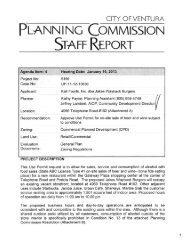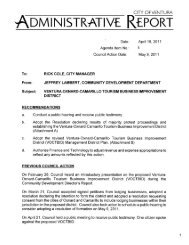Saticoy & Wells Community Plan & Development ... - City Of Ventura
Saticoy & Wells Community Plan & Development ... - City Of Ventura
Saticoy & Wells Community Plan & Development ... - City Of Ventura
You also want an ePaper? Increase the reach of your titles
YUMPU automatically turns print PDFs into web optimized ePapers that Google loves.
<strong>Saticoy</strong> & <strong>Wells</strong> <strong>Community</strong> <strong>Plan</strong> and Code EIRSection 5.0 Growth Effects and Other CEQA Sectionsthe first conclusive measurements being made in the last half of the 20th century. Concentrationsof CO 2 in the atmosphere have risen approximately 35%, since the Industrial Revolution. Per theIPCC (2007), the global atmospheric concentration of carbon dioxide has increased from a preindustrialvalue of about 280 parts per million (ppm) to 379 ppm in 2005. The atmosphericconcentration of CO 2 in 2005 exceeds the natural range over the last 650,000 years (180 to 300 ppm)as determined from ice cores. The average annual carbon dioxide concentration growth rate waslarger during the last 10 years (1995–2005 average: 1.9 ppm per year) than it has been since thebeginning of continuous direct atmospheric measurements (1960–2005 average: 1.4 ppm per year),although there is year-to-year variability in growth rates.Methane. Methane (CH 4 ) is an effective absorber of radiation, though its atmosphericconcentration is less than that of carbon dioxide and its lifetime in the atmosphere is limited to 10-12 years, compared to some other GHGs. It is approximately 20 times more effective at trappingheat in the atmosphere than CO 2 (global warming potential [GWP] 20x that of CO 2 ). Over the last250 years, the concentration of CH 4 in the atmosphere increased by 148% (IPCC 2007).Anthropogenic sources of CH 4 include landfills, natural gas and petroleum systems, agriculturalactivities, coal mining, wastewater treatment, stationary and mobile combustion, and certainindustrial processes (USEPA, April 2008).Nitrous Oxide. Concentrations of nitrous oxide (N 2 O) also began to rise at the beginning ofthe industrial revolution. N 2 O is produced by microbial processes in soil and water, includingthose reactions which occur in fertilizers that contain nitrogen. Use of these fertilizers hasincreased over the last century. Nitrous oxide’s GWP is 300 times that of CO 2 .Fluorinated Gases (HFCS, PFCS and SF 6 ). Fluorinated gases, such as hydrofluorocarbons(HFCs), perfluorocarbons (PFCs) and sulfurhexafluoride (SF 6 ), are greenhouse gases that areemitted from a variety of industrial processes. Fluorinated gases are used as substitutes for ozonedepletingsubstances, such as chlorofluorocarbons (CFCs), hydrochlorofluorocarbons (HCFCs),and halons, which have been regulated since the mid-1980s because of their ozone-destroyingpotential and are phased out under the Montreal Protocol and Clean Air Act Amendments of 1990.Fluorinated gases are typically emitted in smaller quantities than CO 2 , CH 4 , and N 2 O, but eachmolecule can have a much greater global warming effect. SF 6 is the most potent greenhouse gasthat the IPCC has evaluated.5.3.2 Greenhouse Gas InventoryWorldwide anthropogenic emissions of GHGs were approximately 40,000 million metric tons ofcarbon dioxide equivalent (CDE 1 ), including ongoing emissions from industrial and agriculturalsources, but excluding emissions from land use changes (i.e., deforestation, biomass decay) (IPCC,2007). CO 2 emissions from fossil fuel use accounts for 56.6% of the total emissions of 49,000 millionmetric tons CDE (includes land use changes) and all CO 2 emissions are 76.7% of the total. Methaneemissions account for 14.3% and N 2 O emissions for 7.9% of GHGs (IPCC, 2007).1Carbon dioxide equivalent (CDE or CO 2 E) is a quantity that describes, for a given mixture and amount of GHGs, the amount ofCO 2 (usually in metric tons; million metric tons [megatonne] = MMTCO 2 E = terragram [Tg] CO 2 Eq; 1,000 MMT = gigatonne) thatwould have the same global warming potential (GWP) when measured over a specified timescale (generally, 100 years).<strong>City</strong> of <strong>Ventura</strong>5-5
















